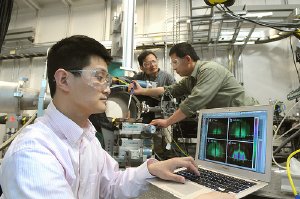May 17 2010
A collaboration between the Advanced Photon Source and Center for Nanoscale Materials at U.S. Department of Energy's (DOE) Argonne National Laboratory has "seen" the crystallization of nanoparticles in unprecedented detail.
"Nanoscience is a hot issue right now, and people are trying to create self-assembled nanoparticle arrays for data and memory storage," Argonne assistant physicist Zhang Jiang said. "In these devices, the degree of ordering is an important factor."
In order to call up a specific bit of data, it is ideal to store information on a two-dimensional crystal lattice with well-defined graphical coordinates. For example, every bit of information of a song saved on a hard drive must be stored at specific locations, so it can be retrieved later. However, in most cases, defects are inherent in nanoparticle crystal lattices.
 Assistant physicist Zhang Jiang (from left) examines a X-ray diffraction as physicist Jin Wang and nanoscientist Xiao-Min Lin prepare a sample at one of the Advanced Photon Source’s beamlines. The Argonne scientists have examined nanoparticle crystallization in unprecedented detail using the high powered X-rays of the APS.
Assistant physicist Zhang Jiang (from left) examines a X-ray diffraction as physicist Jin Wang and nanoscientist Xiao-Min Lin prepare a sample at one of the Advanced Photon Source’s beamlines. The Argonne scientists have examined nanoparticle crystallization in unprecedented detail using the high powered X-rays of the APS.
"Defects in a lattice are like potholes on a road," Argonne physicist Jin Wang said. "When you're driving on the highway, you would like to know whether it is going to be a smooth ride or if you will have to zigzag in order to avoid a flat tire. Also, you want to know how the potholes form in the first place, so we can eliminate them."
Controlling the degree of ordering in nanoparticle arrays has been elusive. The number of nanoparticles a chemist can make in a small volume is astonishingly large.
"We can routinely produce 1014 particles in a few droplets of solution. That is more than the number of stars in the Milky Way Galaxy," Argonne nanoscientist Xiao-Min Lin. "To find conditions under which nanoparticles can self-assemble into a crystal lattice with a low number of defects is quite challenging."
Because nanoparticles are so small, it is not easy to see how ordered the lattice is during the self-assembly process. Electron microscopy can see individual nanoparticles, but the field of view is too small for scientists to get a "big picture" of what the ordering is like in macroscopic length scale. It also doesn't work for wet solutions.
"With local ordering, one cannot assume the same order exists throughout the whole structure; it's like seeing a section of road and assuming it is straight and well constructed all the way to the end," Wang said.
The same group of researchers at Argonne, together with their collaborators at the University of Chicago, discovered that under the right conditions, nanoparticles can float at a liquid-air interface of a drying liquid droplet and become self-organized.
This allows the two-dimensional crystallization process to occur over a much longer time scale. "You typically don't expect metallic particles to float. It is like throwing stones into a pond and expecting them to float on the surface," Lin said. "But in the nanoworld, things behave differently."
Using high-resolution X-ray scattering at the Advanced Photon Source (APS), Jiang and the others examined the crystallization process in unprecedented detail as it forms in real time. They discovered that the nanoparticle arrays formed at the liquid-air interface can enter a regime of a highly crystalline phase defined in the classical two-dimensional crystal theory. Only when the solvent starts to dewet from the surface, do defects and disorder begin to appear.
"We can probe the entire macroscopic sample and monitor what's happening in real time," Jiang said. "This allows us to understand what parameters are important to control the self-assembly process."
With this level of understanding, the scientists hope that one day devices such as the iPod Nano can be made from nanoparticles.
A paper on this research was published in Nano Letters.
The Advanced Photon Source at Argonne National Laboratory is one of four synchrotron radiation light sources supported by the U.S. Department of Energy's Office of Science, Office of Basic Energy Sciences (BES). The APS is the source of the Western Hemisphere's brightest x-ray beams for research in virtually every scientific discipline. More than 3,500 researchers representing universities, industry, and academic institutions from every U.S. state visit the APS each year to carry out both applied and basic research in support of the BES mission.
The Center for Nanoscale Materials at Argonne National Laboratory is one of the five DOE Nanoscale Science Research Centers (NSRCs), premier national user facilities for interdisciplinary research at the nanoscale, supported by the DOE Office of Science. Together the NSRCs comprise a suite of complementary facilities that provide researchers with state-of-the-art capabilities to fabricate, process, characterize and model nanoscale materials, and constitute the largest infrastructure investment of the National Nanotechnology Initiative. The NSRCs are located at DOE's Argonne, Brookhaven, Lawrence Berkeley, Oak Ridge and Sandia and Los Alamos national laboratories.
The U.S. Department of Energy's Argonne National Laboratory seeks solutions to pressing national problems in science and technology. The nation's first national laboratory, Argonne conducts leading-edge basic and applied scientific research in virtually every scientific discipline. Argonne researchers work closely with researchers from hundreds of companies, universities, and federal, state and municipal agencies to help them solve their specific problems, advance America's scientific leadership and prepare the nation for a better future. With employees from more than 60 nations, Argonne is managed by UChicago Argonne, LLC for the U.S. Department of Energy's Office of Science.